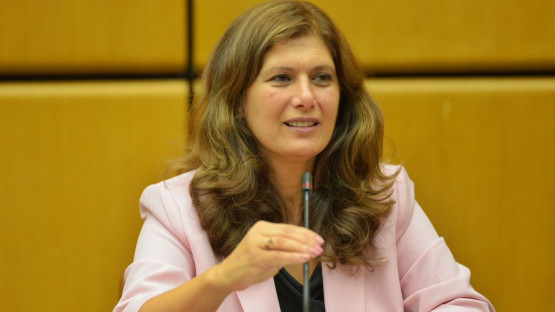Khreis’s first mentor was her father. He was a school principal who fostered a supportive academic environment at home. “He always gave me the same opportunities as my brothers. He strived to help me develop skills applicable to any discipline, such as critical thinking, analysis and self-expression,” she said. “He made me who I am.”
As in many STEM fields, there were few women studying technology at her university, and Khreis was frequently the only woman in her class. “It was often challenging, but I would just become more determined, and this made me stronger,” she recalls.
After a few years working in the private sector in Lebanon, Khreis moved to Austria where she had her first professional experience in an international organization as an IT Consultant at the Organization for Security and Co-operation in Europe (OSCE). She embraced the multicultural environment.
Motivated by the IAEA’s impact on many aspects of people’s lives, Khreis joined the Agency in 1998 as IT Coordinator and Project Manager. Later, as IT Service Manager and then Unit Head of IT Services Design, she worked on the implementation of IT service management best practices to support Agency staff. In 2014, she became Head of the Client Services Section, a position she held for ten years. “Through this role, I had the privilege of working directly with all departments to understand their needs and decide how to best serve them,” she said.
Today, Khreis manages 120 staff and leads the use of digital capabilities at the IAEA to add value through IT. Khreis describes her role as “an enabler, leveraging technology to enable business outcomes and to drive operational efficiency.” By collaborating closely with colleagues across the organization, she uses her understanding of their specific needs to ensure that IT investments are aligned with the organization’s strategic goals. “My aim is to make a difference to the Agency’s work by understanding how we can support stakeholders from an IT perspective to do their work more easily and more efficiently, to enable them to be more effective in what they do,” she said.
Going forward, Khreis aims to identify areas where digital transformation initiatives and innovation can further enhance work processes and overall efficiency, focusing on areas such as artificial intelligence, data management, analytics, visualization and decision making capabilities.
When asked about her professional achievements so far, she said, “Being the IAEA’s first woman Chief Information Officer and Director of Information Technology is a great achievement, and I am also particularly proud of having built highly motivated teams throughout my career.”
Khreis attributes much of her career success to her persistence and the ability to recognize opportunities. In her view, a supportive environment for women depends very much on an organization’s leadership and policies that support gender equality, diversity and the elimination of bias. “I truly believe that diversity creates excellence,” she said.
Khreis advocates for girls and young women to pursue studies in IT and believes this needs to start at home by encouraging them to explore scientific fields and building confidence in their abilities with a ‘you can do it’ attitude. “Women have always faced challenges in STEM-related fields, and that includes women in IT,” she said. Khreis coaches younger colleagues and regularly promotes the field through IT workshops for 11- to 16-year-old girls during the annual Vienna Daughters’ Day event.
Khreis’s advice to young women beginning their professional journey in this evolving field is to “embrace your passion and be resilient. Obstacles and setbacks are natural in any career, but don’t let anyone stop you. Be confident and remember that challenges often create great opportunities.”





